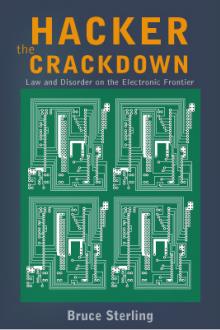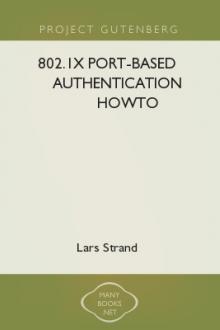Hacker Crackdown by Bruce Sterling (the reader ebook txt) 📖

- Author: Bruce Sterling
- Performer: 055356370X
Book online «Hacker Crackdown by Bruce Sterling (the reader ebook txt) 📖». Author Bruce Sterling
Nevertheless Fry Guy’s crimes would be directly attributed to LoD in much future police propaganda. LoD would be described as “a closely knit group” involved in “numerous illegal activities” including “stealing and modifying individual credit histories,” and “fraudulently obtaining money and property.” Fry Guy did this, but the Atlanta Three didn’t; they simply weren’t into theft, but rather intrusion. This caused a strange kink in the prosecution’s strategy. LoD were accused of “disseminating information about attacking computers to other computer hackers in an effort to shift the focus of law enforcement to those other hackers and away from the Legion of Doom.”
This last accusation (taken directly from a press release by the Chicago Computer Fraud and Abuse Task Force) sounds particularly farfetched. One might conclude at this point that investigators would have been well-advised to go ahead and “shift their focus” from the “Legion of Doom.” Maybe they SHOULD concentrate on “those other hackers”—the ones who were actually stealing money and physical objects.
But the Hacker Crackdown of 1990 was not a simple policing action. It wasn’t meant just to walk the beat in cyberspace—it was a CRACKDOWN, a deliberate attempt to nail the core of the operation, to send a dire and potent message that would settle the hash of the digital underground for good.
By this reasoning, Fry Guy wasn’t much more than the electronic equivalent of a cheap streetcorner dope dealer. As long as the masterminds of LoD were still flagrantly operating, pushing their mountains of illicit knowledge right and left, and whipping up enthusiasm for blatant lawbreaking, then there would be an INFINITE SUPPLY of Fry Guys.
Because LoD were flagrant, they had left trails everywhere, to be picked up by law enforcement in New York, Indiana, Florida, Texas, Arizona, Missouri, even Australia. But 1990’s war on the Legion of Doom was led out of Illinois, by the Chicago Computer Fraud and Abuse Task Force.
The Computer Fraud and Abuse Task Force, led by federal prosecutor William J. Cook, had started in 1987 and had swiftly become one of the most aggressive local “dedicated computer-crime units.” Chicago was a natural home for such a group. The world’s first computer bulletin-board system had been invented in Illinois. The state of Illinois had some of the nation’s first and sternest computer crime laws. Illinois State Police were markedly alert to the possibilities of white-collar crime and electronic fraud.
And William J. Cook in particular was a rising star in electronic crimebusting. He and his fellow federal prosecutors at the U.S. Attorney’s office in Chicago had a tight relation with the Secret Service, especially go-getting Chicago-based agent Timothy Foley. While Cook and his Department of Justice colleagues plotted strategy, Foley was their man on the street.
Throughout the 1980s, the federal government had given prosecutors an armory of new, untried legal tools against computer crime. Cook and his colleagues were pioneers in the use of these new statutes in the real-life cut-and-thrust of the federal courtroom.
On October 2, 1986, the US Senate had passed the “Computer Fraud and Abuse Act” unanimously, but there were pitifully few convictions under this statute. Cook’s group took their name from this statute, since they were determined to transform this powerful but rather theoretical Act of Congress into a real-life engine of legal destruction against computer fraudsters and scofflaws.
It was not a question of merely discovering crimes, investigating them, and then trying and punishing their perpetrators. The Chicago unit, like most everyone else in the business, already KNEW who the bad guys were: the Legion of Doom and the writers and editors of PHRACK. The task at hand was to find some legal means of putting these characters away.
This approach might seem a bit dubious, to someone not acquainted with the gritty realities of prosecutorial work. But prosecutors don’t put people in jail for crimes they have committed; they put people in jail for crimes they have committed THAT CAN BE PROVED IN COURT. Chicago federal police put Al Capone in prison for income-tax fraud. Chicago is a big town, with a rough-and-ready bare-knuckle tradition on both sides of the law.
Fry Guy had broken the case wide open and alerted telco security to the scope of the problem. But Fry Guy’s crimes would not put the Atlanta Three behind bars—much less the wacko underground journalists of PHRACK. So on July 22, 1989, the same day that Fry Guy was raided in Indiana, the Secret Service descended upon the Atlanta Three.
This was likely inevitable. By the summer of 1989, law enforcement were closing in on the Atlanta Three from at least six directions at once. First, there were the leads from Fry Guy, which had led to the DNR registers being installed on the lines of the Atlanta Three. The DNR evidence alone would have finished them off, sooner or later.
But second, the Atlanta lads were already well-known to Control-C and his telco security sponsors. LoD’s contacts with telco security had made them overconfident and even more boastful than usual; they felt that they had powerful friends in high places, and that they were being openly tolerated by telco security. But BellSouth’s Intrusion Task Force were hot on the trail of LoD and sparing no effort or expense.
The Atlanta Three had also been identified by name and listed on the extensive anti-hacker files maintained, and retailed for pay, by private security operative John Maxfield of Detroit. Maxfield, who had extensive ties to telco security and many informants in the underground, was a bete noire of the PHRACK crowd, and the dislike was mutual.
The Atlanta Three themselves had written articles for PHRACK. This boastful act could not possibly escape telco and law enforcement attention.
“Knightmare,” a high-school age hacker from Arizona, was a close friend and disciple of Atlanta LoD, but he had been nabbed by the formidable Arizona Organized Crime and Racketeering Unit. Knightmare was on some of LoD’s favorite boards—“Black Ice” in particular—and was privy to their secrets. And to have Gail Thackeray, the Assistant Attorney General of Arizona, on one’s trail was a dreadful peril for any hacker.
And perhaps worst of all, Prophet had committed a major blunder by passing an illicitly copied BellSouth computer-file to Knight Lightning, who had published it in PHRACK. This, as we will see, was an act of dire consequence for almost everyone concerned.
On July 22, 1989, the Secret Service showed up at the Leftist’s house, where he lived with his parents. A massive squad of some twenty officers surrounded the building: Secret Service, federal marshals, local police, possibly BellSouth telco security; it was hard to tell in the crush. Leftist’s dad, at work in his basement office, first noticed a muscular stranger in plain clothes crashing through the back yard with a drawn pistol. As more strangers poured into the house, Leftist’s dad naturally assumed there was an armed robbery in progress.
Like most hacker parents, Leftist’s mom and dad had only the vaguest notions of what their son had been up to all this time. Leftist had a day-job repairing computer hardware. His obsession with computers seemed a bit odd, but harmless enough, and likely to produce a well-paying career. The sudden, overwhelming raid left Leftist’s parents traumatized.
The Leftist himself had been out after work with his co-workers, surrounding a couple of pitchers of margaritas. As he came trucking on tequila-numbed feet up the pavement, toting a bag full of floppy-disks, he noticed a large number of unmarked cars parked in his driveway. All the cars sported tiny microwave antennas.
The Secret Service had knocked the front door off its hinges, almost flattening his Mom.
Inside, Leftist was greeted by Special Agent James Cool of the US Secret Service, Atlanta office. Leftist was flabbergasted. He’d never met a Secret Service agent before. He could not imagine that he’d ever done anything worthy of federal attention. He’d always figured that if his activities became intolerable, one of his contacts in telco security would give him a private phone-call and tell him to knock it off.
But now Leftist was pat-searched for weapons by grim professionals, and his bag of floppies was quickly seized. He and his parents were all shepherded into separate rooms and grilled at length as a score of officers scoured their home for anything electronic.
Leftist was horrified as his treasured IBM AT personal computer with its forty-meg hard disk, and his recently purchased 80386 IBM-clone with a whopping hundred-meg hard disk, both went swiftly out the door in Secret Service custody. They also seized all his disks, all his notebooks, and a tremendous booty in dogeared telco documents that Leftist had snitched out of trash dumpsters.
Leftist figured the whole thing for a big misunderstanding. He’d never been into MILITARY computers. He wasn’t a SPY or a COMMUNIST. He was just a good ol’ Georgia hacker, and now he just wanted all these people out of the house. But it seemed they wouldn’t go until he made some kind of statement.
And so, he levelled with them.
And that, Leftist said later from his federal prison camp in Talladega, Alabama, was a big mistake.
The Atlanta area was unique, in that it had three members of the Legion of Doom who actually occupied more or less the same physical locality. Unlike the rest of LoD, who tended to associate by phone and computer, Atlanta LoD actually WERE “tightly knit.” It was no real surprise that the Secret Service agents apprehending Urvile at the computer-labs at Georgia Tech, would discover Prophet with him as well.
Urvile, a 21-year-old Georgia Tech student in polymer chemistry, posed quite a puzzling case for law enforcement. Urvile—also known as “Necron 99,” as well as other handles, for he tended to change his cover-alias about once a month—was both an accomplished hacker and a fanatic simulation-gamer.
Simulation games are an unusual hobby; but then hackers are unusual people, and their favorite pastimes tend to be somewhat out of the ordinary. The best-known American simulation game is probably “Dungeons & Dragons,” a multi-player parlor entertainment played with paper, maps, pencils, statistical tables and a variety of oddly-shaped dice. Players pretend to be heroic characters exploring a wholly-invented fantasy world. The fantasy worlds of simulation gaming are commonly pseudo-medieval, involving swords and sorcery—spell-casting wizards, knights in armor, unicorns and dragons, demons and goblins.
Urvile and his fellow gamers preferred their fantasies highly technological. They made use of a game known as “G.U.R.P.S.,” the “Generic Universal Role Playing System,” published by a company called Steve Jackson Games (SJG).
“G.U.R.P.S.” served as a framework for creating a wide variety of artificial fantasy worlds. Steve Jackson Games published a smorgasboard of books, full of detailed information and gaming hints, which were used to flesh-out many different fantastic backgrounds for the basic GURPS framework. Urvile made extensive use of two SJG books called GURPS HIGH-TECH and GURPS SPECIAL OPS.
In the artificial fantasy-world of GURPS SPECIAL OPS, players entered a modern fantasy of intrigue and international espionage. On beginning the game, players started small and powerless, perhaps as minor-league CIA agents or penny-ante arms dealers. But as players persisted through a series of game sessions (game sessions generally lasted for hours, over long, elaborate campaigns that might be pursued for months on end) then they would achieve new skills, new knowledge, new power. They would acquire and hone new abilities, such as marksmanship, karate, wiretapping, or Watergate burglary. They could also win various kinds of imaginary booty, like Berettas, or martini shakers, or fast cars with ejection seats and machine-guns under





Comments (0)